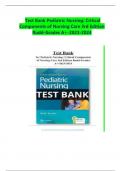Exam (elaborations)
TEST BANK PEDIATRIC NURSING CRITICAL COMPONENTS OF NURSING CARE 3RD EDITION RUDD-GRADES A+ with complete solutions
Course
PEDIATRIC NURSING: CRITICAL COMPONENTS
Institution
PEDIATRIC NURSING: CRITICAL COMPONENTS
TEST BANK PEDIATRIC NURSING: CRITICAL COMPONENTS OF NURSING CARE 3RD EDITION RUDD-GRADES A+ with complete solutionsTEST BANK PEDIATRIC NURSING: CRITICAL COMPONENTS OF NURSING CARE 3RD EDITION RUDD-GRADES A+ with complete solutionsTEST BANK PEDIATRIC NURSING: CRITICAL COMPONENTS OF NURSING CARE 3RD ...
[Show more]
Preview 4 out of 509 pages
Uploaded on
August 31, 2024
Number of pages
509
Written in
2024/2025
Type
Exam (elaborations)
Contains
Questions & answers
3rd edition test bank pediatric nursing critical components o
pediatric nursing critical components of nursing
rudd grades a with complete solutions
Institution
PEDIATRIC NURSING: CRITICAL COMPONENTS
Course
PEDIATRIC NURSING: CRITICAL COMPONENTS
$18.99
100% satisfaction guarantee
Immediately available after payment
Both online and in PDF
No strings attached
Test Bank Pediatric Nursing: Critical




